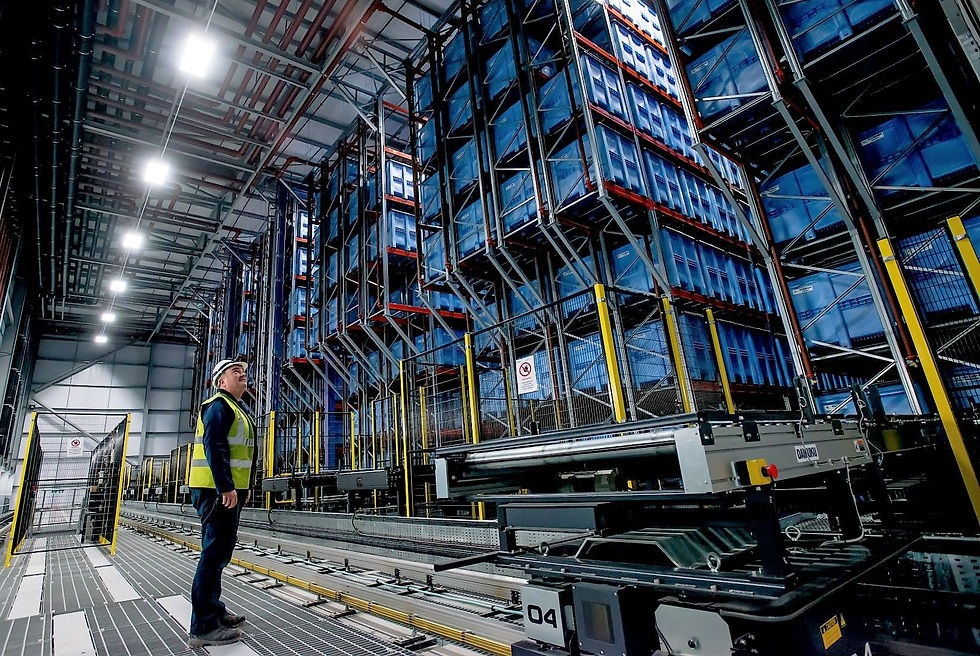Daifuku Q3 Report: The State of Intralogistics
- Kirsty Tull

- Nov 10, 2024
- 4 min read
Updated: Dec 6, 2024
Australia and New Zealand
Edition 3 - 2024
Intralogistics continues to play a critical role in shaping the global supply chain ecosystem. As industries increasingly adopt automation, robotics, and data-driven solutions, the landscape for warehousing, distribution, and logistics is transforming rapidly. This report consolidates recent studies on automation and retail competitiveness to present a comprehensive view of the state of intralogistics for the quarter.

Daifuku's AS/RS system
Automation as a Key Driver in Intralogistics
Automation remains at the forefront of intralogistics innovation. According to the MMH
Research: Automation Usage Implementation Study, the implementation of automated
solutions within warehouses and distribution centres has continued to accelerate throughout
2024. Approximately 60% of companies have adopted some form of automation, with another 25% planning to implement these technologies within the next two years.
Automation technologies such as Automated Storage and Retrieval Systems (AS/RS), Smart Transfer Vehicles (STVs), and autonomous mobile robots (AMRs) are reshaping how warehouses manage inventory, reduce labour costs, and improve throughput. The study also reveals that many organisations are moving beyond pilot stages and investing heavily in scalable solutions, driven by rising labour shortages and increasing consumer demand for speed and accuracy.
Daifuku‘s emphasis on scalable solutions, tailored to specific needs, aligns with these
trends, showcasing the importance of flexibility in automation investments. Scalability remains crucial, as businesses must address varying peaks in demand, particularly in sectors like e-commerce and FMCG distribution.
Rising Demand for Industrial Real Estate in Australia
JLL‘s Australian Industrial Market Overview highlights a record demand for industrial real
estate, fueled by the booming e-commerce market and the rapid expansion of logistics
and distribution facilities. Vacancy rates across key industrial hubs in Sydney, Melbourne, and Brisbane remain historically low, pushing rents higher and leading to increased development of speculative industrial assets.
This surge in demand is coupled with ongoing supply chain disruptions and the need for
businesses to maintain larger and more extensive inventories. JLL also emphasises the
growing importance of strategic warehouse locations, particularly those close to urban
centres and major transport hubs, to facilitate last-mile delivery and shorten lead times.
Optimising warehouse footprints and utilising vertical storage solutions such as AS/RS are
essential to maximising space in high-demand areas. The trend toward more compact,
tech-enabled warehousing is a direct response to escalating real estate costs and limited land availability.

The Role of Sustainability in Future Intralogistics
A much-discussed topic at the recent CeMAT Australia event, sustainability is emerging as a
core driver of change within the intralogistics sector. Green logistics, energy-efficient automation, and decarbonisation are key trends shaping the future of the supply chain. Companies are increasingly focusing on reducing their carbon footprint in terms of transportation and warehousing operations.
Technologies such as electric fleets, energyefficient material handling equipment, and
incorporating renewable energy into warehouse design are becoming essential in meeting
regulatory requirements and consumer expectations for greener operations. Businesses investing in automation must now consider energy usage and environmental impact as part of their longterm strategy, making sustainability a critical component of intralogistics planning.

Daifuku's solar panels installed on the roof of Hini Arata Kan. The system generated approximately 270,000 kWh of power, which reduced CO2 emissions by 110 tons.
Retail Competitiveness and Consumer Expectations
As retail continues to evolve, the role of intralogistics in maintaining competitiveness has never been more critical. PowerRetail‘s Maximising Retail Competitiveness report highlights the direct link between efficient logistics operations and customer satisfaction, with
70% of consumers indicating that delivery speed is a crucial factor influencing purchase
decisions.
Retailers are under immense pressure to provide same-day or next-day delivery options,
which has fueled investment in localised micro-fulfilment centres and last-mile delivery
networks. This trend has also prompted the adoption of advanced inventory management
systems and real-time data analytics to ensure stock availability and optimise order fulfilment.
Furthermore, consumer buying behaviour is increasingly leaning towards omnichannel
experiences, with customers expecting seamless integration between online and offline shopping. Retailers that can harness intralogistics technologies to offer flexible delivery and return options while maintaining cost efficiency will gain a competitive edge.
Investment Trends in Intralogistics and Supply Chain Infrastructure
JLL‘s Navigating Australian Logistics and Industrial Real Estate Investment Markets
report indicates that investor interest in logistics and industrial assets continues to surge.
The resilience of the logistics sector has made industrial real estate a safe investment.
As a result, institutional investors are increasingly allocating capital to logistics facilities, driving further development across Australia.
Intralogistics in September 2024 is characterised by significant technological advancements,
increasing demand for industrial real estate, and a growing emphasis on sustainability and
customer satisfaction. Automation, sustainability, and strategic warehousing locations are key trends that will continue to define the future of the sector. Businesses looking to stay ahead in this competitive landscape must prioritise investments in scalable, energy-efficient
automation solutions and remain agile in responding to consumer expectations for speed
and flexibility.
Daifuku, with its extensive expertise in automated systems and smart intralogistics solutions, assists customers worldwide in navigating these trends and optimising their operations for the future. As intralogistics continues to evolve, companies that embrace innovation will be better equipped to thrive in a rapidly changing marketplace.



Comments